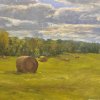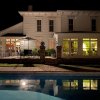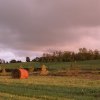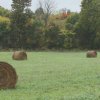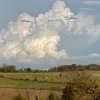In October 2019 Carol Henry and I moved to Kentucky to open our bed & breakfast called Wildflower Ranch Inn. Once in the new home, we started the B&B business in January 2020… we were gung-ho on the Kentucky Bourbon Trail. With 5 rent-able guest rooms, not including our 1500SF private suite, we were ready for the roaring ‘20s. In total, it is a 10,000SF 1871 house with a pool! The former pool house is now the art studio, we call The Art Distillery.
COVID really took the wind out of our sails in March 2020, but guest nights have been picking back up since Memorial Day. This October we had our most productive month so far. We had a lot of breakfast guests and a LOT of laundry! So, Most days I am very happy where we are… smack dab in the middle of Kentucky and in the middle of the North/South Mason/Dixon line.
People here ask me nearly every day “Why on earth would you move from California to Ken-TUCKY!?! I just smile and say — with a pause “Well, just look around in any direction!†Living in the midwest has been a fairly easy transition for me. Perhaps is it the years of my Dad’s attempt to have a countrified version of life wherever we lived. I loved that he always had a birdcage, or aviary, or just an open yard with birds of many assorted feathers. We had peacocks, turkeys, geese, chickens, dove, pheasants. There was always morning chores of feeding and re-freshing their water. When we lived in Rowland Heights, CA, one of the bird pins was for pigeons. Once in a while—usually in the late afternoon—we would let the doors fly open and the entire brood would fly high into the sky and tumble and roll with locked wings, falling back to earth. Getting roof-high, they would recover and fly back to the heights and tumble and roll again. This would go on for several minutes then one would take-charge and they all would take off over the horizon. Watching them fly was one of my fondest memories of living there. We would not see them for an hour or two but they would always return before dark. Their homing beacon was strong. They knew that they would have a safe roost with a fresh batch of crushed grain to renew their strength and satisfy their evening slumber.
Dad grew up on a large ranch in South Los Angeles. It was in Torrance, CA. His uncles were farmers there. From the 1910’s to the mid-70’s they grew lima beans, oat hay and, sometimes corn. When I was a young boy, I loved seeing the fields freshly tilled. All of their fields have long been sold off to development. Condos, tilt-up concrete warehouses and, strip-malls now stand where their rotating crops once went on for as far as the eye can see. They would plant and pray for rain. There was no irrigation for them back then.
As I look out of my studio window in Kentucky, rolling hills are covered with rotating crops as far as the eye can see. On the other side of our property is a smaller, 50-acre field that had tall grass growing, mixed with weeds, wildflowers, and thistles. About a month ago, the grass was cut, raked, and made into big round hay bales. A lovely sight to see. I now have made two paintings of these fields of baled grasses. We currently have thousands of acres of soybeans around us drying on the vine. The leaves of the soybeans are long gone and the shells have withered and dried. Soon, a thrashing machine will come to collect what’s left standing and separate the dried beans from the husks and stems. The beans will fill an open container on a trailer and the debris will scatter and compost for next year’s crop of corn.
The fields on both sides of us are owned by an old-timer named Sandy Simms. He is a self-proclaimed hermit and doesn’t socialize much anymore. He reminds me of an old german wolfhound. Sandy is 88 and works his fields nearly every day. He owns a couple of bulldozers and loves to move dirt. I was in the studio and could hear something, a chugging motor of a big machine. I thought it might be time for harvest. I looked out and Sandy was clearing out a “silt-pond.†I walked up to his bulldozer to say hi. He turned off the motor and we had a friendly chat for a spell. He likes to inform me about the land and his objectives. He is teaching some things to this city-slicker from the west coast. This silt-pond gets cleared every 5 years, or so he told me. Well, at 88, it might be his last, or perhaps not. We will see. He also pushes over old deadwood and stacks up the trunks along a creek-bed or pond. Then he pushes dirt over the top of it to partly bury the logs. Over time, they compost, while giving strength to the new creekside. There is a lot to learn about the land and the proper caring of it. I hear stories about Sandy from anyone that knows him. He’s like a kid with an old Tonka toy tractor. The only time I have seen any dirt in Kentucky is when Sandy is grading a hillside or a slope of the creek. Otherwise, Kentucky ground is covered in grass and undergrowth and every kind. Like Hawaii, Kentucky gets its fair share of rain throughout the year. It ain’t like California!
The first day I had met Sandy was an early morning in December. He was sitting in his Ford Ranger with a cup of McDonalds oatmeal and a coffee. He was watching a few dozen Canada Geese on his pond next to our property. This is only one of his many ponds. Sandy has been good to us. The first thing he did after meeting him and his oatmeal, was to have one of his guys take out a couple of our dead Sugar Pines that were eye-sores and add them to a pile he had on the side of the pond. I told Sandy that I needed to hire someone to do the work for me, and he said that he appreciated that someone wanted to look after this property and he would “take care of itâ€. The next day, there were two healthy dudes doing the deed… no charge. That’s downright hospitable.
I love the work of Wendell Berry. He is an author here in Kentucky. He lives along the Kentucky river on an old family farm. He took his family to NYC for a while to take a teaching job in the English Department, but soon left the Big City to return to work the land. His homing beacon was strong too! I do wish sometimes that I had a “home†to go back to, but there is no place like that left to go. So, I happily make home where I am. I have that wandering “thing†— an exploration gene that allows me to accept what is in front of me and have hope for the next day. So, Wendell Berry writes stories and poetry from his home about sustainable farming, spiritual musings, relationships and the importance of solitude and simple living. Carol and I went to a book fair in February and we got to meet him. Now 86, he has slowed down a lot too. He signed his latest book for me “The Art of Loading Brush†which is a collection of short stories sprinkled with poetry. Many of his poetry books are illustrated by a Canadian wood engraver named Wesley Bates — his works are very inspiring to this old linolium block artist. I have already collected about 6 books that Bates has illustrated — I have one more coming next week. His great design sense has been honed after thousands of hours slowly carving into dense blocks of orange-wood. I have a children’s book illustration commission to get finished in the next few months and his work is giving me the inspiration needed to make a go of it. It will be a series of linolium block prints. That work has stalled since being in KY, but I have been isolating myself in the studio for a few hours at a time to get back into the swing of it. I love the isolation that allows me to silently work on carving into a block of linolium. It is one of the most peaceful things I do. This self-therapy brings a tactile satisfaction that few things offer.
I brought old Sandy into the studio last week to show him some of my paintings. He thought they were nice, but once he saw the 40†block all carved into, he told me “ THIS is wonderful. What a work of art! I like this better than anything!†he added “I like it because it’s ‘earthy’†Sandy gets it. He is an artist. He sits in his bulldozer and cuts big groves into the earth, sculpting the landscape.
Discover more from Rich Brimer — a contemporary oil painter
Subscribe to get the latest posts sent to your email.
